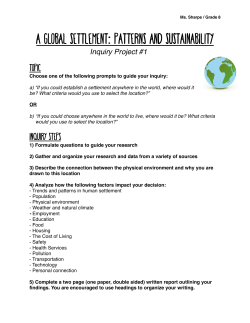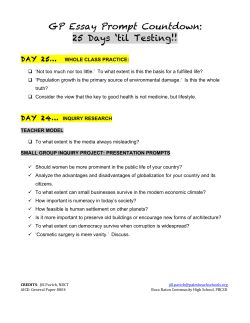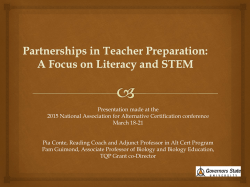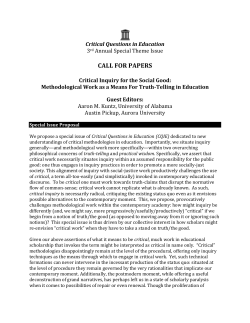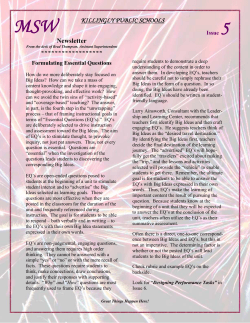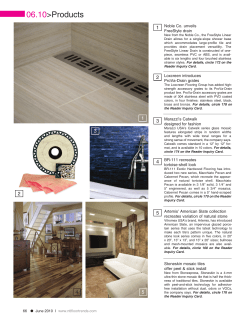
S i c r
in the early years YOUNG CHILDREN are naturally curious. The desire to question, hypothesize, explore, and investigate is part of their very being. This inherent sense of inquiry provides the foundation for science with young children, from inquisitive toddlers to curious third-graders. Early childhood educators can build on children’s questions, eagerness, and enthusiasm to help them learn science. We can foster scientific knowledge by thoughtfully preparing rich environ- e c n e Sci e in th Air Sherrie Bosse, Gera Jacobs, and Tara Lynn Anderson “Teacher, can we try to make square bubbles?” “How come leaves don’t turn blue in the fall?” “Will our seeds grow if we water them with orange juice?” Sherrie Bosse, EdD, is an associate professor in curriculum and instruction at the University of South Dakota in Vermillion. Sherrie has 21 years of experience in early education as a teacher, administrator, and teacher educator. Her research interests include early learning environments and teacher preparation. sbosse@usd.edu Gera Jacobs, EdD, is a professor of early childhood education at the University of South Dakota. She is a member of the NAEYC Governing Board. Gera began her career as an elementary science teacher and taught preschool through eighth grade for many years. Gera.Jacobs@usd.edu Tara Lynn Anderson, MA, is an elementary school teacher in Sioux Falls, South Dakota, and has taught preschool through fifth grade. Tara has presented at national and state conferences, sharing her ideas for involving young children in hands-on science. Tara.Anderson@usd.edu Cluster illustration © Melanie Hope Greenberg. This article is available in an online archive at www.naeyc.org/yc. ® 10 2, 3 ments, indoors and out; by introducing a scientific vocabulary during engaging activities and long-term studies or themes; and by providing many opportunities for children to problem solve and investigate. Science, like the very air around us, can infuse life into our programs. Creating an environment that promotes science One easy way to incorporate science into the daily classroom routine is to set up a discovery area where children can explore. This can be on a table or shelving unit or in another creative space. The key to designing a quality discovery area is carefully selecting a variety of age-appropriate materials (such as magnifiers, a balance scale, prisms, and plants) that will introduce children to the wonders of the natural world. Rotate additional natural materials, books, and manipulatives to reinvigorate interest and reflect seasonal changes. Very young children relish the tactile sensations of smooth shells, fuzzy cattails, and rough pinecones. As children grow and develop, they begin to formulate and answer questions by using tools and materials to measure, observe, weigh, and record their findings. At first, teachers may need to model the use of some materials and help children consider the best types of tools to use in their explorations. We can ask open-ended questions that model the inquiry process: “I wonder how we could find out how Reprinted from Young Children • November 2009 The best inv estiga The outdoor environment is a rich many tiny seeds are in a single pod?” By tion topic s are tho area for scientific exploration. As chilusing descriptive words with the materise that child dren of all ages view the veins of a leaf in als, we introduce children to vocabulary ren encou sunlight, discover that rocks become a that will grow along with their investiganter on a d aily basis much richer color when wet, or inhale the tions of the world. and that scent of a lilac bush in full bloom, their In addition to defining a discovery allow for curiosity leads to questions and fosters area, teachers can integrate materihands-on inquiry. connections to the natural world. als that support science inquiry in all Some playgrounds lack nature, and with areas of the room, helping children it, firsthand opportunities for children to learn science concepts as well as explore, discover, and build scientific vocabliteracy, math, and more. Add both ulary. When teachers add planter boxes or small garden fiction and nonfiction books with science themes to the plots to the outdoor areas, children can plant and care for classroom library as well as to the writing, housekeepflowers or vegetables. Gardening is fertile ground for preing, and block areas. Place a balance scale, a basket of dicting, comparing, and observing the characteristics of materials of different sizes and weights, and graph paper living things; the experiences may prompt long-term studin the math area. For the water table, provide a variety of ies of growing cycles, food chains, or habitats. Gardens, objects, such as different measuring containers, tubing, and shrubs, and trees attract birds, butterflies, and insects that items that children can use to explore sinking and floating. lead children to ask questions about the natural world. Supplement a bird feeder visible from a classroom window Some outdoor spaces include a gathering area for diswith an illustrated field guide, binoculars, and a clipboard cussions or read-alouds. Books relating to the things that for documenting the numbers and types of winged visitors. children are noticing and wondering about are especially engaging. Some programs set up an outdoor art area where children can create with natural materials, a music area, a building area, a messy play area, or a water feature (National Arbor Day Foundation 2007). © Gerald Marella Undertaking in-depth explorations Reprinted from Young Children • November 2009 Long-term studies or projects focusing on science-related topics let children achieve a much deeper understanding of scientific concepts than do isolated activities or experiences. The topic of study depends on the children’s interests and the resources available. Note the topics that children raise in conversations—perhaps the wildlife in your area, the water system, seasonal changes, mechanical As childr en get old operations (elevaer, we can enco tors, dump trucks, urage the m to cranes), or recycling. predict a nd try ou Consulting the t different cond applicable science itions, en hancing content standards their und erstandin for the age level you g of the influence teach and considerof light, s oil, and ing the firsthand water on the grow opportunities with th and developm the subject matter ent of pla nt life. also can help you choose a topic. The best investigation topics are those that children encounter on a daily basis and that allow for hands-on inquiry. 11 Once you and the children have chosen what to study, involve them in researching the topic. Read books and articles, look up information on the Web, and explore other sources of information on the topic. Resources for researching children’s questions are generally abundant, and the information can be connected to other areas of daily life (Helm & Katz 2001; Worth & Grollman 2003). Invite knowledgeable members of the community to come in and share their expertise. Visit places where children can learn firsthand about the topic—they may be as close as your playground or a nearby park. Encourage children to represent what they are learning through drawing, writing, and photography. Display their work on documentation panels in the classroom or hallway. Create class books documenting each stage of the inquiry process through photos, children’s quotes, and some teacher commentary. Bind the pages in photo albums or laminate and secure them with metal rings or plastic binding combs. Class-created books about long-term investigations allow children to revisit prior learning and to read and reflect. Children can take turns taking home the books to share with their families. Meeting science standards—“It’s a breeze” Science standards outline age- and gradeappropriate concepts. The National Science Education Standards (NRC 1996) include content standards for K–4. They can be accessed free online at www.nap.edu/catalog. php?record_id=4962. The content standards include the areas of • Science as Inquiry (pp. 121–23 online) • Physical Science (pp. 123–27) • Life Science (pp. 127–29) • Earth and Space Science (pp. 130–34) • Science and Technology (pp. 135–38) • Science in Personal and Social Perspectives (pp. 138–41) Although some of these areas may seem too complex for younger children, the standards can guide teachers in selecting engaging, hands-on experiences and activities suited to children’s developmental levels. Photos © Ellen B. Sen isi Science as Inquiry. Frequent opportunities to predict, 12 investigate, estimate, classify, and graph hone children’s inquiry skills. Modeling the use of “I wonder . . .”, “What if . . . ?” and “How can we find out?” introduces children to the basis of science inquiry. When children pose a question, we can introduce the process of observing, researching, creating and testing hypotheses, and collaborating to find answers. Write questions on a flip chart and revisit them during the inquiry process. This helps children realize that it takes time to understand some things and that we don’t need to give up when an answer isn’t readily available. Reprinted from Young Children • November 2009 Physical Science. Hands-on exploration of readily accessible materials encourages children to investigate the properties of objects. In the block area, for example, cardboard tubes and lengths of plastic rain gutters or cove molding, along with balls and things with wheels, help children develop notions about the position and motion of objects as they create ramps and tunnels. At the water table, tubing, measuring cups, funnels, turkey basters, and eyedroppers foster beginning understandings of volume, weight, gravity, and force. Earth and Space Science. Young children can record the number of sunny versus cloudy days, check the playground rain gauge and record precipitation, and notice the effect of wind direction on a windsock. A special rock brought back from a family vacation may spark interest in examining, categorizing, and classifying different types of © Ellen B. Senisi Life Science. Through observation, children can formulate questions about the characteristics of living things and measure, record, discuss, and think about their observations. Planting seeds and watching the changes that take place over time is a meaningful activity for children of all ages. As children get older, we can encourage them to predict and try out different conditions, enhancing their understanding of the influence of light, soil, and water on the growth and development of plant life. Observing animals in their natural habitats (birds, squirrels, insects, and worms seen on the playground or in a nearby park) or caring for classroom pets helps children develop a deeper understanding of living things. Hatching chicks in an incubator, watching fish in a small aquarium, or observing a butterfly’s amazing transformation cycle invites rich classroom discussions and allows older children to record and document their observations. rocks. Simply playing at the sand and water tables develops familiarity with the properties of earth materials. Science and Technology. Distinguishing between natural items and man-made items can enhance children’s understandings of science and technology, especially the technological tools that have become part of our daily lives. Simple machines (such as apple peelers, ice cream churns, and egg timers) invite hands-on investigations of how machines function. Opportunities for children to use developmentally appropriate software and digital cameras can be catalysts for curiosity and wonder. © Maria Wynne Science in Personal and Social Perspectives. Reprinted from Young Children • November 2009 Discussions and activities about conserving resources and recycling bring science into personal and social perspectives. Brainstorming ways to repurpose discarded objects develops problem-solving skills and higher order thinking. Teachers can spark children’s consideration of how we each impact the environment by sharing a story from the library or creating their own, possibly leaving the ending to the imaginations of the listeners. Making paper offers 13 We can in tentionall y plan enga ging activ ities in en vironmen ts that invit e explora tion, documen tation, dis cussion, and the develo pment of n ew ideas . a hands-on lesson in recycling and changes in matter. Children tear up old construction paper (a great fine motor activity), put the scraps in a blender with water, spread the mixture on an old window screen or other mesh material, and let the pulp dry for several days. The handmade paper makes an interesting addition to the art area. Children can immerse themselves in scientific roles when we add props for health care professions or ecology themes to the dramatic play area, organize field trips, or arrange classroom visits by professionals in those areas. When children consider the reasons behind events or phenomena, they can better understand scientific concepts than when asked to recall facts or answer yes/no questions. Thoughtful teachers help children expand on initial responses and observations to analyze (examine how and why), compare and contrast (distinguish between same and different), and problem solve (envision possible solutions and weigh their advantages and disadvantages). Teachers can ask open-ended questions and provide ample opportunities for practice to foster the ability to make connections between ideas, link past and current events, and identify patterns or sequences. Problem solving is an invaluable skill often rooted in our early experiences. We all encounter the occasional daunting task, but the choice between “I can’t” and “I’ll try” often predicts the outcome of the challenge. Children gain insight into negotiating challenging situations when they hear and see us thinking aloud, talking through a problem: “We have some birdseed, but we don’t have a bird feeder. How can we feed the birds? We have to think of a way to solve this problem. There are a lot of materials in our recycling box. Shall we see if we can make a bird feeder from some of those items?” Taking advantage of teachable moments to involve children in problem solving can help them develop the skills to independently and successfully meet future challenges. Science is in the air Science is part of our everyday lives, and every day is filled with science possibilities. Children can share questions and ideas during class meetings and circle times. Displaying photos and documentation of science explorations can help children revisit past investigations and connect new information to prior experiences. Open-ended questions and invitations to try out predictions (hypotheses) empower children to actively seek answers. Science vocab- 14 © Tara Lynn Anderson Building higher order thinking skills and positive approaches to learning ulary interspersed in daily exchanges builds on children’s curiosity and desire to understand the world (see “Building Language and Scientific Literacy”). Exploration and inquiry come naturally to children. Adults can nurture this curiosity, helping children develop science inquiry skills and higher order thinking. We can intentionally plan engaging activities in environments that invite exploration, documentation, discussion, and the development of new ideas. When science is in the air, infused into daily classroom life, we encourage wonder and help children develop a greater appreciation of the world and their place in it. References Helm, J.H., & L. Katz. 2001. Young investigators: The project approach in the early years. New York: Teachers College Press. National Arbor Day Foundation. 2007. Learning with Nature idea book: Creating nurturing outdoor spaces for children. Lincoln, NE: Author. NRC (National Research Council). 1996. National Science Education Standards: Observe, interact, learn, change. Washington, DC: National Academies Press. www.nap.edu/catalog.php?record_id-4962 Pianta, R., K. LaParo, & B. Hamre. 2008. The Classroom Assessment Scoring System (CLASS) manual. Baltimore: Brookes. Tabors, P., C. Snow, & D. Dickinson. 2001. Homes and schools together: Supporting language and literacy development. In Beginning literacy with language: Young children learning at home and School, eds. D.K. Dickinson & P.O. Tabors, 313–34. Baltimore: Brookes. Worth, K., & S. Grollman. 2003. Worms, shadows, and whirlpools: Science in the early childhood classroom. Portsmouth, NH: Heinemann; Washington, DC: NAEYC. Reprinted from Young Children • November 2009 Building Language and Scientific Literacy Helping children expand their vocabulary is one of the best ways to ensure that they become successful readers and writers (Tabors, Snow, & Dickinson 2001). It is also an effective way to help children learn science concepts. To think through and explain why something might happen and why something might work, children need to have the words to express these thoughts. Add science vocabulary words to a classroom word wall. Model the use of terms such as estimate, predict, atmosphere, and habitat in day-to-day conversation and encourage children to use the vocabulary themselves: “You’re right, Casey. The vinegar bubbled up when you added the baking soda—just as you predicted it would. What other mixtures would you like to investigate?” As children build their literacy skills, provide forms for recording observations so they can also grow in their inquiry skills and practice using scientific vocabulary. Language modeling and concept development (Pianta, LaParo, & Hamre 2008) can make a real difference in children’s learning. 1. Model science-related vocabulary, using scientific terms as children interact with engaging materials and planned experiences. 2. Encourage meaningful conversations and expand on what children say. 3. Provide many opportunities for using science-related language and engaging in hands-on experiences that deepen children’s understanding of the words. 4. Ask open-ended questions that promote predicting skills and teach problem-solving skills: “Now that we’ve frozen water into all these interesting shapes, which of them do you think will melt most quickly? Let’s write down our predictions. How can we find out if we’re right?” Let children make their own predictions, try things out, and note what works and why. 5. Use words to describe our actions and the children’s actions: “I’ll pour this water into the cup of cornstarch as you stir. Let’s observe what happens as we try to pick up the interesting mixture we’ve just made. Is it more like a solid or a liquid?” Copyright © 2009 by the National Association for the Education of Young Children. See Permissions and Reprints online at www.naeyc.org/yc/permissions. Reprinted from Young Children • November 2009 15
© Copyright 2025
